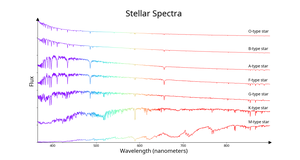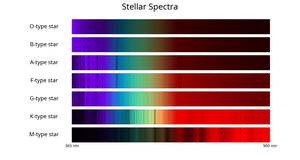Glossary term: Spectral Type
Description: Stars are classified into spectral types according to the appearance of features in their spectra.
For most stars, the spectral type is based primarily on the temperature of the stellar surface and follows a sequence: O, B, A, F, G, K, and M, listed from hottest to coldest. This sequence has recently been extended to the cooler types L, T, and Y. These three represent mostly brown dwarfs, but some objects with spectral type L are stars rather than brown dwarfs.
There are also letters to classify special classes of star. Carbon stars are stars with strong spectral features from molecules containing carbon. These are classified as type C. S-type stars are intermediate between types K or M and C in that the surface abundances of oxygen and carbon are nearly equal. White dwarfs are divided into a series of different types based on features in their spectra; all these types begin with the letter D (DA, DB, etc.). Hot, massive stars with broad emission lines have a series of types beginning with W (WN, WC, WO).
The present notation is a legacy from the first modern classification attempt, undertaken at Harvard College Observatory. The classes, originally designated A–Q, alphabetically, were subsequently reordered as a temperature sequence, resulting in the main types still used today. The main spectral classes are subdivided, denoted by the numbers from zero to nine. The Sun is spectral type G2. Additional letters refer to special characteristics (such as e for stars with bright emission lines), and the luminosity class, denoted by Roman numerals, may also be specified.
Related Terms:
- A-type Star
- B-type Star
- F-type Star
- K-type Star
- Spectrum
- Star
- Sun
- G-type Star
- M-type Star
- O-type Star
- Luminosity Class
See this term in other languages
Term and definition status: This term and its definition have been approved by a research astronomer and a teacher
The OAE Multilingual Glossary is a project of the IAU Office of Astronomy for Education (OAE) in collaboration with the IAU Office of Astronomy Outreach (OAO). The terms and definitions were chosen, written and reviewed by a collective effort from the OAE, the OAE Centers and Nodes, the OAE National Astronomy Education Coordinators (NAECs) and other volunteers. You can find a full list of credits here. All glossary terms and their definitions are released under a Creative Commons CC BY-4.0 license and should be credited to "IAU OAE".
If you notice a factual error in this glossary definition then please get in touch.
Related Diagrams
Stellar spectral types
Credit: IAU OAE/SDSS/Niall Deacon
License: CC-BY-4.0 Creative Commons Attribution 4.0 International (CC BY 4.0) icons
Stellar spectral types - bands
Credit: IAU OAE/SDSS/Niall Deacon
License: CC-BY-4.0 Creative Commons Attribution 4.0 International (CC BY 4.0) icons










